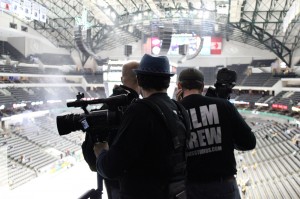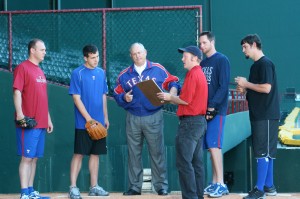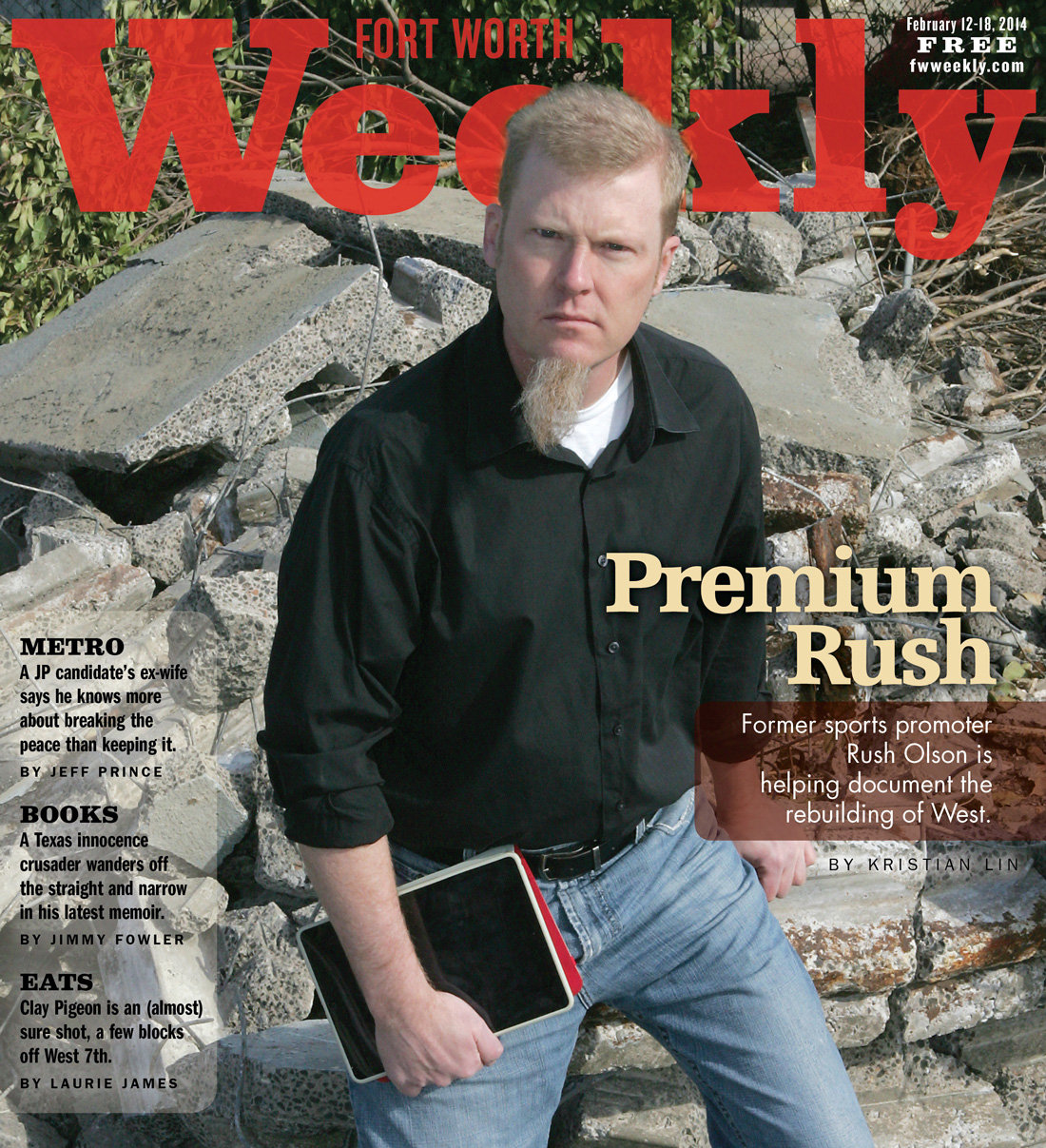For starters, Rush Olson’s first name comes from his mother’s side of his family. “People always think it’s something to do with Rush Limbaugh or the Canadian band Rush,” said the 45-year-old Fort Worth native. One of his early bosses in broadcasting said that the name seemed to fit him, because he was always in a hurry to get things done.
Now, after a colorful 12-year career as a creative director in the Texas Rangers’ organization, his energy has led him to strike out on his own, both as a sports consultant and as a documentary filmmaker. It’s the latter career that has taken him down to West, Texas, to chronicle the devastation and the rebuilding there since the fertilizer plant explosion last April. After years spent filming commercials for sports teams, doing justice to the work and the emotions in that town will be a major challenge.
A tall man who retains the build of the athlete he once was, Olson seems a natural fit for a career in sports. However, his beard, neatly trimmed but several inches long (known as a “billy goat” among beard aficionados), is a look that sticks out in a sports crowd. He started growing it a few years ago. “Unfortunately, it grows faster than the hair on top of my head,” he joked.
“I had just gone through a breakup with my girlfriend,” said Olson, who is divorced with no children. “I felt like I wasn’t perceived as the creative guy at the office, and I thought the beard would help. If you take the beard out, my face is very nondescript.” While he hopes to make a fiction film one day, his energy is currently devoted to chronicling the construction work on the high school in West that was severely damaged.
Before he started work, Olson had never been to West except to stop in for kolaches on the way to San Antonio. Right now, Olson is capturing the design phase of the school rebuilding process, as well as the kids attending classes in temporary buildings. (In fact, the plan for the new school is due to be submitted for school board’s approval this Wednesday.) The rebuilding work, as well as the currently untitled documentary project, is scheduled to go on for the next two to three years. Olson makes it down to West about once a month.
“It’s very freeing,” he said. “I’m not ever going to forget that I love sports, but I’m glad to have the chance to do other things.”
********
Olson grew up on the east side of Fort Worth, the son of Edward Olson, the chair of physical education at Texas Wesleyan University, and Fran, a teacher at Fort Worth Academy of Fine Arts. (They’re now retired, but his sister, Missi Kovachev, currently teaches at Fort Worth Academy.)

“It was awesome growing up” with the prestigious private school’s amenities, he said. “We got to use the gym, the tennis courts. My parents put an emphasis on education, obviously, but my father always viewed athletics as part of the education process.” Rush played basketball and tennis at Fort Worth Country Day School, after having played football, baseball, and soccer as a boy.
He can pinpoint exactly when he first thought of going into broadcasting for a living. “It was Career Day at my high school,” he said. “[Channel 5 sportscaster] Scott Murray came and spoke about what he did. I was doing theater, and I thought, ‘He gets to talk a lot and watch a lot of sports.’ It seemed like a logical pairing. That was my motivation to go into communications.”
After graduating from San Antonio’s Trinity University (and serving an internship at KXAS-TV/Channel 5), he started work in the mailroom at KTVT-TV/Channel 11. While working his way up to a marketing job at the then-independent station, Olson supplemented his income by freelancing as a play-by-play sports announcer on Community Cable Television, calling high school football games, Golden Glove boxing, and even a figure-skating competition for roller skaters at the Will Rogers Memorial Center. The job gave him contacts and knowledge about many facets of the sports industry — at the understaffed station, he ended up doing lots of different jobs.
KTVT had sports, too: the Rangers, the Mavericks, the Stars, and college football. Olson worked on promotional spots for those events, as well as the station’s complement of Disney cartoon shows for children, for which he shot cut-ins with Theatre Arlington founder B.J. Cleveland introducing the programs. In 1994, the station switched its affiliation to CBS, which needed a new home for its programming after being displaced from KDFW-TV/Channel 4 by the fledgling Fox Network.

“That transition was some of the longest hours I’d ever worked,” said Olson. “The move was talked about in newspapers” and repeatedly announced on the station’s promos, he said, but that didn’t mean that viewers understood. “We set up a toll-free hotline so that viewers could find out where their favorite programs were going. I put together a database of where every show was.”
Four years later, Tom Hicks’ Southwest Sports Group acquired KXTX-TV/Channel 39 to broadcast the Rangers and Stars games. Olson promptly followed the work to the new station, getting hired as KXTX’s promotions manager. However, in 2000, Southwest Sports Group sold the rights to the baseball and hockey games to Fox Sports Network, which meant that Southwest Sports no longer needed a TV station.
The move meant that the Rangers needed someone to oversee production of local radio and TV commercials. Olson filled the void. “Working for a professional baseball team was awesome,” he said, using a word that comes frequently to him. There, Olson learned to work with internet video, with Major League Baseball providing equal access and resources to all its teams.
“When there are advances in internet video technology, baseball is on top of it,” he said. The team was initially shooting video footage on analog tape and then digitizing it for the web, but soon the Rangers started buying digital video cameras. “Now we could [put] press conferences on the web 15 minutes after they ended,” he said.
Kelly Calvert first worked with Olson on Channel 39, then moved to the Rangers in 2003, working closely with him when she was the team’s marketing director. She said she was impressed by the TV spots that Olson shot at the ballpark. “Baseball players are not actors, and they have more important things to do, so it’s important that you don’t waste their time,” when shooting promotional spots, she said. “He made everything move efficiently. He wants to win [advertising awards], but he knows that ads are for selling tickets, not just for being cool.”
In making commercials for the Rangers, he was guided by market research that said that fans wanted to see Texas qualities and values reflected in the team’s promotions. One of his favorite commercials showed team president Nolan Ryan grilling too many hot dogs in his backyard. The commercial was filmed in both English and Spanish versions, and Olson smiled as he remembered prevailing on the non-Spanish-speaking Hall of Fame pitcher to deliver one line of dialogue in Spanish.
“I was nervous, but it was worth it,” he said.
********












